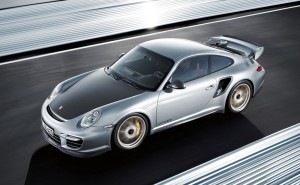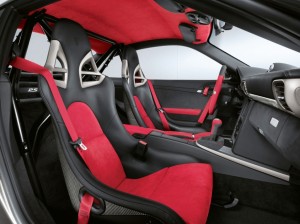
The ultimate 911 accelerates from 0-60 in 3.4 seconds, has a top speed of 205 mph and laps the Nürburgring-Nordschleife track in 7:18.
The latest Porsche 911 model is without question the fastest and most powerful road-going sports car ever built in the history of the fabled German marque.
With horsepower increased by 90 and weight reduced 154 pounds (70 Kg) compared with the old 911 GT2 (last sold in the U.S. during the 2009 model year), the new GT2 RS has a power-to-weight ratio of 4.9 pounds per horsepower, the best ratio in its class.
While these numbers can be respected for what is a rare and ultra-high-performance sports car, taken in the larger context of U.S. energy independence, national security from terrorist-supporting oil nations, greenhouse gases and the latest ecological disaster – the BP oil spill/fish kill – they could be viewed differently. (Porsche Power Shift as Qatar Sheikh Joins Board and Hans-Peter Porsche Retires!)

Lightweight bucket seats of carbon-fiber plastic are standard, as are lightweight door panels with straps instead of handles.
Porsche is tacitly acknowledging the potential marketing problem it faces by touting the 2011 GT2 RS achieves a reduction of approximately 5% for both fuel consumption and CO2 emissions based on the European test cycle when compared with the previous GT2. It is engineering at its best. The question remains as to whether such a car is a positive or negative in image terms?
Moreover, insiders say the rating of the existing GT3 as a gas guzzler – currently Porsche’s only guzzler model on sale in the U.S. – was not part of the plan and is a cause for concern since the U.S. is still Porsche’s largest market, even at its now depressed levels. EPA ratings for the GT3 are 14 mpg city and 21 highway, very good given the performance involved, but perhaps approaching the lower end of the socially acceptable scale.
Porsche executives are hoping that the revised 3.6-liter six-cylinder boxer engine in the new GT2 RS will not be rated as a guzzler. Only time will tell, since the car does not go on sale until this October so it is not rated yet. And they were taken by surprise when the GT3 was dubbed a guzzler.
Such fuel economy and the resulting relatively high CO2 emissions levels have been largely, if not entirely irrelevant, to buyers of high-powered German cars. Moreover, German makers have a long history of paying the required gas-guzzler fines incurred by such fuelishness – passed on to buyers of course – when they violated U.S. fuel economy regulations. They all have done it for decades, while Congress looked the other way.
However, this loophole is currently under scrutiny by industry critics and pressure groups, as the National Highway Traffic Safety Administration and the U.S. Environmental Protection Agency work out final fuel economy rules – and the methodology used to calculate them – which will lead to a 35.5 mile per gallon average in 2016. Passenger cars will need to average 42 mpg under the proposed rules.
Auto company lobbyists are working this issue behind the scenes in pay-for-play Washington, DC, and it appears that an accommodation will be made for the vehicles driven by the rich when the final rules are announced, but this does not solve the image issue or the social disapproval that guzzling incurs.
Porsche’s total U.S. sales to date this year of just fewer than 7,000 units (U.S. April Auto Sales Anemic at Best) means is a minor player in one sense, but is now part of the much larger Volkswagen empire. (In December 2009, VW took 49.9% ownership in Porsche AG at a price of €3.9 billion. It will buy the balance in 2011.) How this all sorts out is a thorny image issue not only for Porsche, but also for all makers of low fuel efficiency vehicles.
To its credit, Porsche has previously said that no Panamera sedan will be subject to a gas-guzzler tax when it goes on sale this June. (Porsche Adds V6 Engines to Panamera Sedans) The existing V8 models, the Panamera S, the Panamera 4S and the Panamera Turbo are only 400 to 500 horsepower sports sedans, rated by the U.S. Environmental Protection Agency at 16 city and 24 highway. The turbo is 15/23.
I have no reason to doubt the excellent engineering firm when it says the new V6 engine will be efficient when official U.S. EPA fuel economy figures are announced closer to the on-sale date. Panamera will have the stop/start mode that the current V8 models have, which shuts the engine off at idle, thereby increasing efficiency. Aside from Japanese hybrids, I think this is the only application of this advanced, fuel saving technology on the U.S. market. The prospect of a 911 – essentially a racecar for the street with – with stop/start at some point in the future is intriguing. Will buyers accept it? And what else will Porsche have to do to increase 911 fuel efficiency going forward?
As to the new RS, buyers will be scarce by design. Limited to just 500 units worldwide, the 911 GT2 RS will be available in the U.S. October 2010 with a MSRP of $245,000. I am guessing that about 100 will be sold here. The GT2 RS is making its world debut at the Moscow Auto Show on August 25, 2010.
